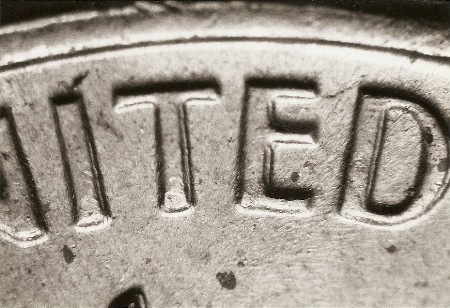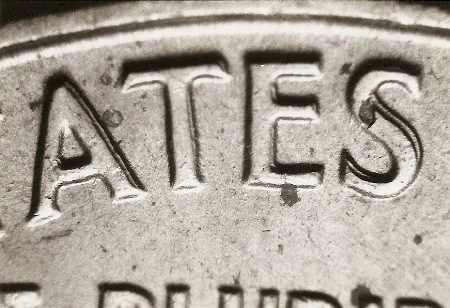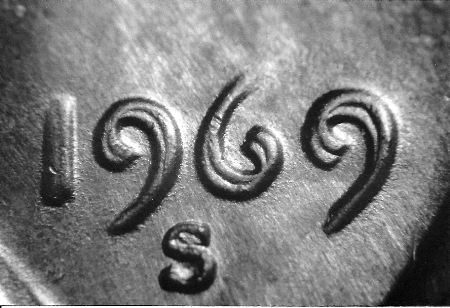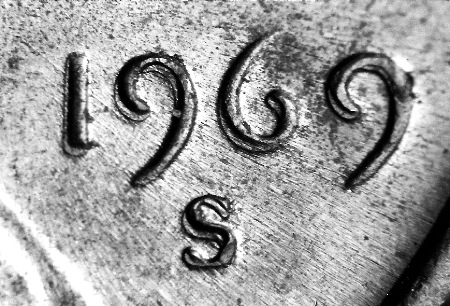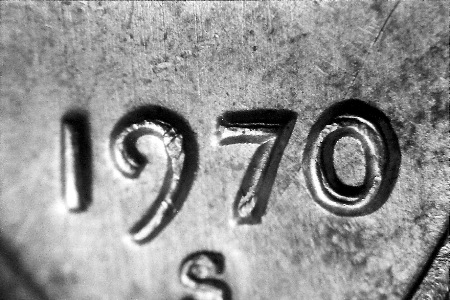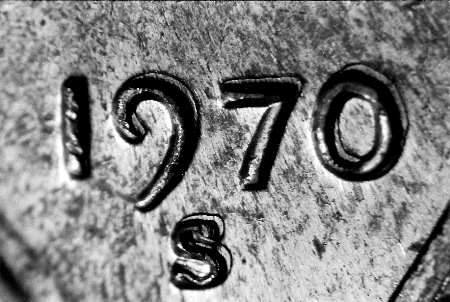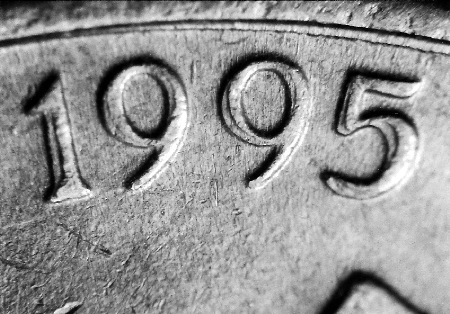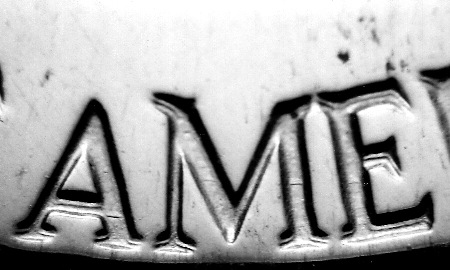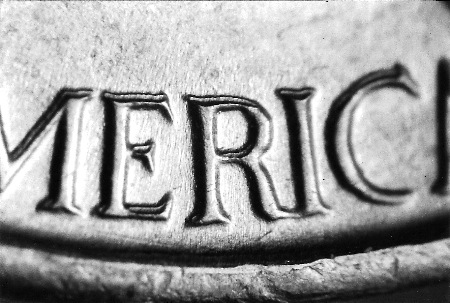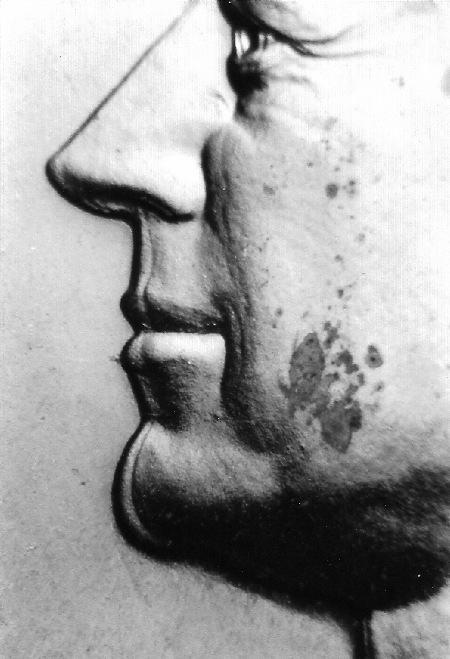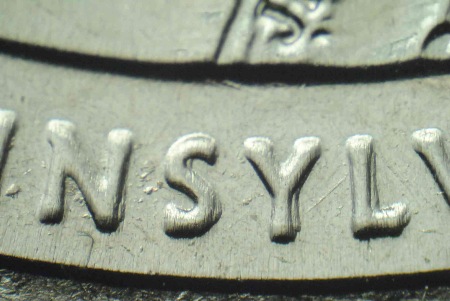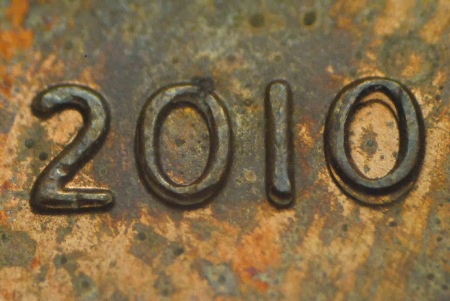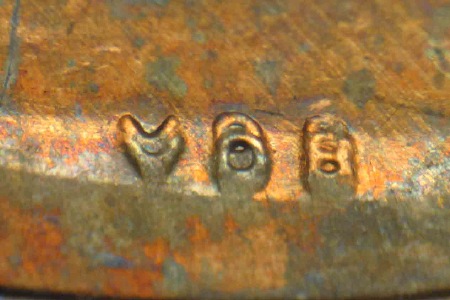


 |
 |
 |
 |
 |
 |
 |
 |
 |
 |
 |
 |
 |
 |
 |
 |
 |
 |
 |
 |
 |
 |
 |
 |
Mechanical doubling is probably the most common form of doubling on U.S. coins and the form of doubling most often confused with doubled dies, especially by those just getting started with collecting die varieties. This form of doubling has been known by a number of different names over the years. It has been referred to as “ejection doubling”, “machine doubling”, “strike doubling”, “shift doubling”, and “shelf doubling”. If you see references to any of these, it is most likely mechanical doubling that is being referred to. The primary characteristic of mechanical doubling on coins with raised design elements is that the secondary image (doubling) has a flat, shelf-like appearance. On genuine doubled dies the secondary image is raised and rounded just like the primary image. Also, genuine doubled dies are characterized by a splitting of the serifs on letters with serifs, or a “notching” of the corners of the letters which are doubled. This splitting of the serifs or notching of the letter corners will not be found on coins with mechanical doubling. Unlike genuine doubled dies for which the doubling is on the die itself (hence the term “doubled die”), mechanical doubling is the result of loose parts in the coining press. These loose parts allow the dies to shift and/or bounce slightly at the moment of impact when the coin is being struck. This slight shifting and bouncing of the dies is what causes the flat, shelf-like appearance of mechanical doubling. The loose coining press parts result from the continuous pounding of the presses as they strike coin after coin, and from wear on the coining press parts. The coining press operators have reported that when they see this doubling on the coins, all they have to do is grab their tools and tighten up all of the loose parts in the coining press. As soon as those loose parts are tightened, the doubling no longer occurs. As we indicated before, this form of doubling is extremely common with numerous examples being produced on all denominations every year. Most serious doubled die collectors view this type of doubling as a form of damage to the coin rather than a collectible form of doubling. We are not saying that you cannot collect this form of doubling, if you are interested in it. Rather, we are saying that you should know the difference between the two forms of doubling and label them properly. Knowing that mechanical doubling is an extremely common form of doubling you also need to be very realistic about any values that are assigned to coins with this common form of doubling. One example of how collectors can be duped by this form of doubling occurred with the discovery of the 1995 Lincoln cent doubled die which had the country in a searching frenzy at that time. Shortly after the discovery of the true doubled obverse die, collectors and dealers were finding 1995 dated Lincoln cents with doubling on the reverse, particularly on the letters of ONE CENT. Dealers and others began selling these for as much as $20 or more. Every one of the specimens seen by myself and other die variety specialists turned out to be mechanical doubling. Anyone purchasing the coins that were being advertised most likely found out after time that the coins they had were not doubled dies and were virtually worthless. Don’t let this happen to you. When the Minnesota State quarter doubled dies were the hot item with their “extra trees”, “extra branches”, and “extra rocks”, many examples of mechanical doubling crossed our desk right along with the genuine doubled dies. The same is true of almost any significant doubled die find. Examples of mechanical doubling quickly follow the reports of the real thing. Learn the difference between true doubled dies, mechanical doubling, and the other worthless forms of doubling. Following are photos of genuine doubled dies as well as examples of mechanical doubling in the same areas as that seen on the genuine doubled dies. Study the photos carefully so that you will be able to tell the difference when looking at actual coins. Our first set of photos has two photos of the genuine Lincoln cent doubled die reverse listed as 1964 1¢ WDDR-001. After each photo of the genuine doubling you will see photos of a 1964 Lincoln cent with mechanical doubling on the same letters as that seen on the genuine doubled die. Study the photos very carefully and hopefully you will see the difference.
The doubling seen above is genuine doubled die doubling on the 1964 Lincoln cent reverse listed as 1964 1¢ WDDR-001.
Here we see mechanical doubling on the same letters of UNITED as those seen in the photo with the genuine doubled die doubling. Note the flat, shelf-like appearance of the doubling in this photo. This is also the reverse of a 1964 Lincoln cent. It is easy to see how the untrained eye can be fooled by the mechanical doubling.
The doubling seen above is also genuine doubled die doubling on the 1964 Lincoln cent reverse listed as 1964 1¢ WDDR-001. Note the strong split serif on the lower S and also the strong notches on the upper left corners of the letters.
This is the mechanical doubling seen on the reverse of a 1964 Lincoln cent. Notice again the flat, shelf-like appearance of the doubling. Also note that there is no split serif on the lower S nor is their any notching at the tops of the letters. The 1969-S Lincoln cent obverse doubled die listed as 1969-S 1¢ WDDO-001 is an extremely rare and popular variety. Following you will see photos of the genuine doubled die doubling on the date, and you will also see mechanical doubling on the date of a different 1969-S Lincoln cent. We often get reports from someone who thinks that he/she has found the rare doubled die when it is actually the very common mechanical doubling that they found. In the photo of the 1969-S cent with the mechanical doubling you will notice that there is also doubling to the mint mark. This is a clue that it is not a genuine doubled die. Prior to 1990 the mint marks were hand punched into the die in a separate operation. While there are some genuine doubled dies prior to 1990 that also have a repunched mint mark, they are few and far between. If the coin with doubling that you found is dated prior to 1990 and shows doubling to both the date and the mint mark, chances are good that it is not a doubled die.
This is doubling on the date of the genuine doubled die listed as 1969-S 1¢ WDDO-001. Note that there is no doubling to the mint mark.
This is mechanical doubling seen on the date and the mint mark of a 1969-S cent. This flat, shelf-like doubling is often confused with the genuine doubled die doubling seen in the previous photo. The doubling on the mint mark is a dead giveaway. Only a few dozen specimens of the Lincoln cent doubled die listed as 1970-S 1¢ WDDO-001 are known to exist. However, 1970-S Lincoln cents showing mechanical doubling are very easy to find. Following you will again see the genuine doubled die doubling to the date followed by a photo of mechanical doubling to the date of a 1970-S cent.
This is the genuine 1970-S cent doubled die listed as 1970-S 1¢ WDDO-001. Again note that there is no doubling to the mint mark.
Here we see common mechanical doubling on the date and mint mark of a 1970-S Lincoln cent. All denominations of U.S. coins are afflicted with mechanical doubling. Following we have a couple of examples of Jefferson nickels showing both genuine doubled dies along with examples of mechanical doubling in the same areas of the coin. Hopefully you will be able to readily see the difference.
This photo shows genuine doubled die doubling on a 2004-P Jefferson nickel that we have listed as 2004-P 5¢ WDDO-001.
Here we have mechanical doubling on the date of a 1995-P Jefferson nickel.
The doubling on the letters of AMERICA seen here is on a genuine doubled die proof nickel listed as 1950 5¢ Pr WDDR-001. Strong notching can be seen on all of the letters.
The doubling seen on the letters of AMERICA on this Jefferson nickel is mechanical doubling. We could go on and on with examples comparing genuine doubled dies with examples of mechanical doubling, but we will close after one more example. Hopefully these will be sufficient enough to help you start weeding out the examples of mechanical doubling that you are finding on your coins. Our final examples show genuine doubled die doubling to the profile of Kennedy on a 1966 Kennedy half dollar and also mechanical doubling to the profile of Kennedy on a 1967 Kennedy half dollar.
This is genuine doubled die doubling on the profile of Kennedy on the doubled die that we have listed as 1966 50¢ WDDO-022. There are several different similar doubled die varieties listed for the 1966 Kennedy half dollars. Some of them have been found in the Special Mint Sets made for that year.
This is mechanical doubling on the profile of Kennedy on a 1967 Kennedy half dollar. When the design elements on a coin are incuse rather than raised, the appearance of mechanical doubling is even more deceptive. Since the design element on the die is raised, when the loose die shifts and bounces it will leave a secondary impression on the coin that is incuse just like the normal design element. All of the characteristics of normal doubled dies, such as split serifs and separation of images, will appear on the mechanical doubling images. Many of the modern coins such as the America The Beautiful quarters have design elements that are incuse. On the reverse of these quarters it is the lettering near the rim. When these incuse design elements show doubling, it is almost always going to be mechanical doubling. The following photos show mechanical doubling to the incuse letters around the rim of a 2011-P Pennsylvania Gettysburg quarter.
The following photos show mechanical doubling on a 2010 Lincoln cent. On LIBERTY and the date we see the typical flat, shelf-like doubling on LIBERTY and the date as they are raised design elements on the coin. On the designer's initials we see strong doubling that looks just like a doubled die, however, the designer's initials are incuse so this is also mechanical doubling.
Click on the following links to see the information on: | ||



